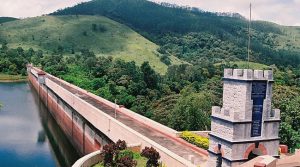 New Delhi: The Kerala government has told the Supreme Court that “no amount of rejuvenation” can perpetuate the 126-year-old “deteriorated” Mullaperiyar dam and there is a limit to the number of years one can keep dams in service through maintenance and strengthening measurers.
New Delhi: The Kerala government has told the Supreme Court that “no amount of rejuvenation” can perpetuate the 126-year-old “deteriorated” Mullaperiyar dam and there is a limit to the number of years one can keep dams in service through maintenance and strengthening measurers.
It said the only permanent solution for removing the “eternal threat owing to the safety concerns” of the dam and for protecting the safety of lakhs of people living in the downstream of Mullaperiyar dam, is to build a new dam in the downstream reaches of the existing dam.
Mullaperiyar Dam was built in 1895 on the Periyar River in the Idukki district of Kerala.
In an affidavit filed before the apex court, the Kerala government has urged the apex court that the proposal to fix the upper rule level of Mullaperiyar dam at 142 feet on September 20 as formulated by Tamil Nadu may be avoided.
“It is submitted that no amount of rejuvenation by any means can perpetuate the 126 years old deteriorated Mullaperiyar dam,” the affidavit said.
“Further, keeping in view the fact that generally as the North-East monsoon extends mostly up to the month of December, it is requested that the maximum water level in the reservoir may be fixed at 140 ft on November 30 based on the rule curve proposed by Kerala,” it said.
On October 28, a bench headed by Justice A M Khanwilkar had said that Tamil Nadu and Kerala would abide by water level notified by the expert committee as per which it would be maintained at 139.5 feet till November 10 in the dam.
The apex court had posted the matter for hearing on November 11 to enable Kerala to file a better affidavit, especially to deal with the issue on the rule curve and about the correct approach in that regard.
In its affidavit, the Kerala government has said that all over the world, citizens, governments and organizations have begun to review the safety of their dams as per modern standards and design criteria.
“Many dams have already been dismantled or decommissioned in an attempt to allay the fears of the people living downstream and to ensure safety to their lives and properties,” it said.
It added that building a new dam below the old Victoria dam in Australia in 1981, when the old dam was found unsafe as per modern safety requirements, is one of the main examples.
It said UN report on ‘Ageing water storage infrastructure: An Emerging Global Risk’ regarding unsafe dams has included Mullaperiyar dam in its case studies of dam ageing and decommissioning.
It said that in 1979, the team of engineers from both the states headed by the then Chairman of CWC had made specific recommendation for constructing a new dam as a permanent solution to the safety problem of the existing Mullaperiyar dam.
The affidavit said that government of Kerala has already put forth the suggestion for constructing a dam during the meetings held at New Delhi chaired by the Union Minister for Water Resources and the Chief Ministers of Kerala and Tamil Nadu, but state of Tamil Nadu had not concurred with the proposal of new dam.
It said the rule curve prepared by Tamil Nadu in consultation with CWC is required to be reconsidered by the supervisory committee in line with the suggestion given by Kerala.
It said the alarming rise in the water level of the dam due to heavy rains which occurred in the catchment of Mullaperiyar dam from October 16 this year and the concerns of Kerala on its safety and the people living downstream of the dam were placed before the court on October 25 for the regulation of water level.
Kerala further said that in the backdrop of past history of sudden upsurges of water level records in the Mullaperiyar reservoir, the state is very vigilant in close monitoring of water levels.
“If water level at Mullaperiyar is kept at a higher level, releases from it will be affecting the already filled Idukki reservoir. In worst case of a cascading failure of Mullaperiyar and Idukki, will result in a catastrophe which is beyond imagination affecting the life and property of 50 lakhs of people residing below the Idukki dam,” it said.
The affidavit said the peak value of upper rule level of 142 feet on September 20 formulated by Tamil Nadu may be reconsidered.
It said there is no comprehensive instrumentation plan including seismic instrumentation for the dam, which lies in seismic zone-III as per the seismic zoning map of India.
“It is admitted that the failure on the part of Tamil Nadu to execute the instrumentation of the dam in a time bound manner is a grave matter that would further weakens the oldest dam in India built during the pre-modern construction technology which would lead to a dreadful disaster of a dam break with unimaginable loss to human life and environment,” it said.
The affidavit said considering the ageing of the dam and the seismic forces to be imposed on the dam, necessary directions may be issued to Tamil Nadu to install instruments in the dam recommended as per the guidelines of CWC.
On October 25, the apex court had said that the supervisory committee should take a “firm decision” on the maximum water level to be maintained in the dam.
